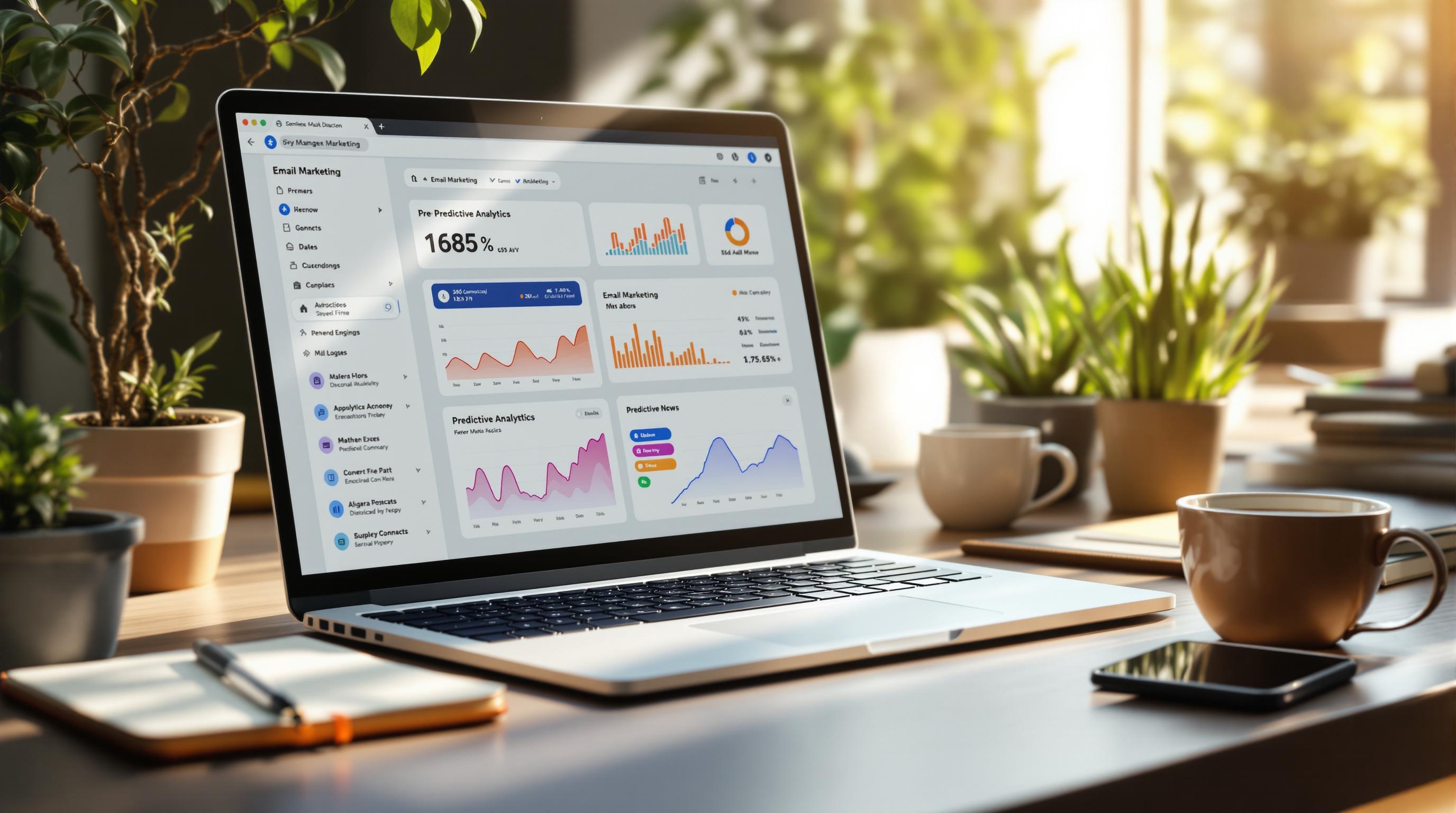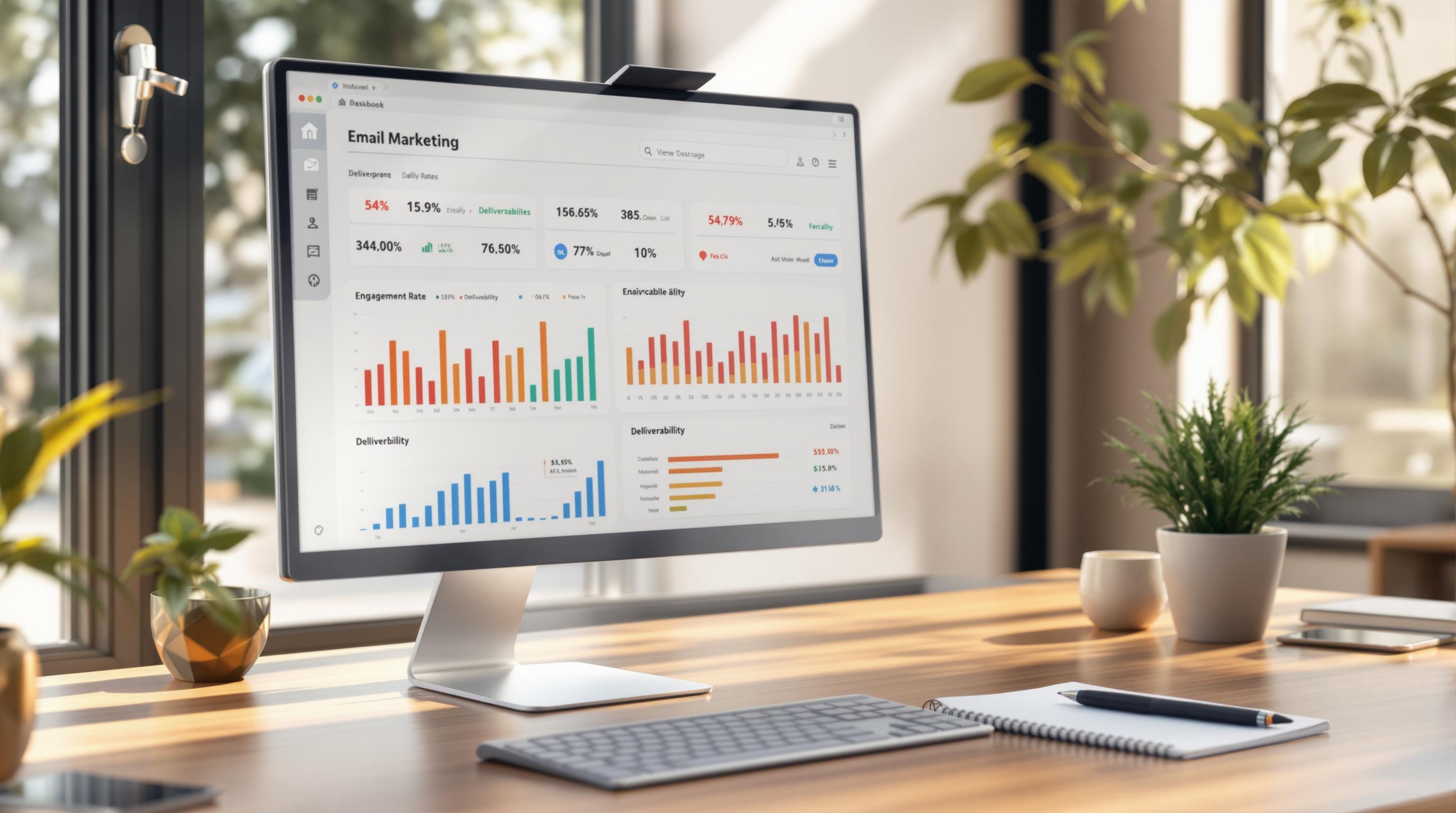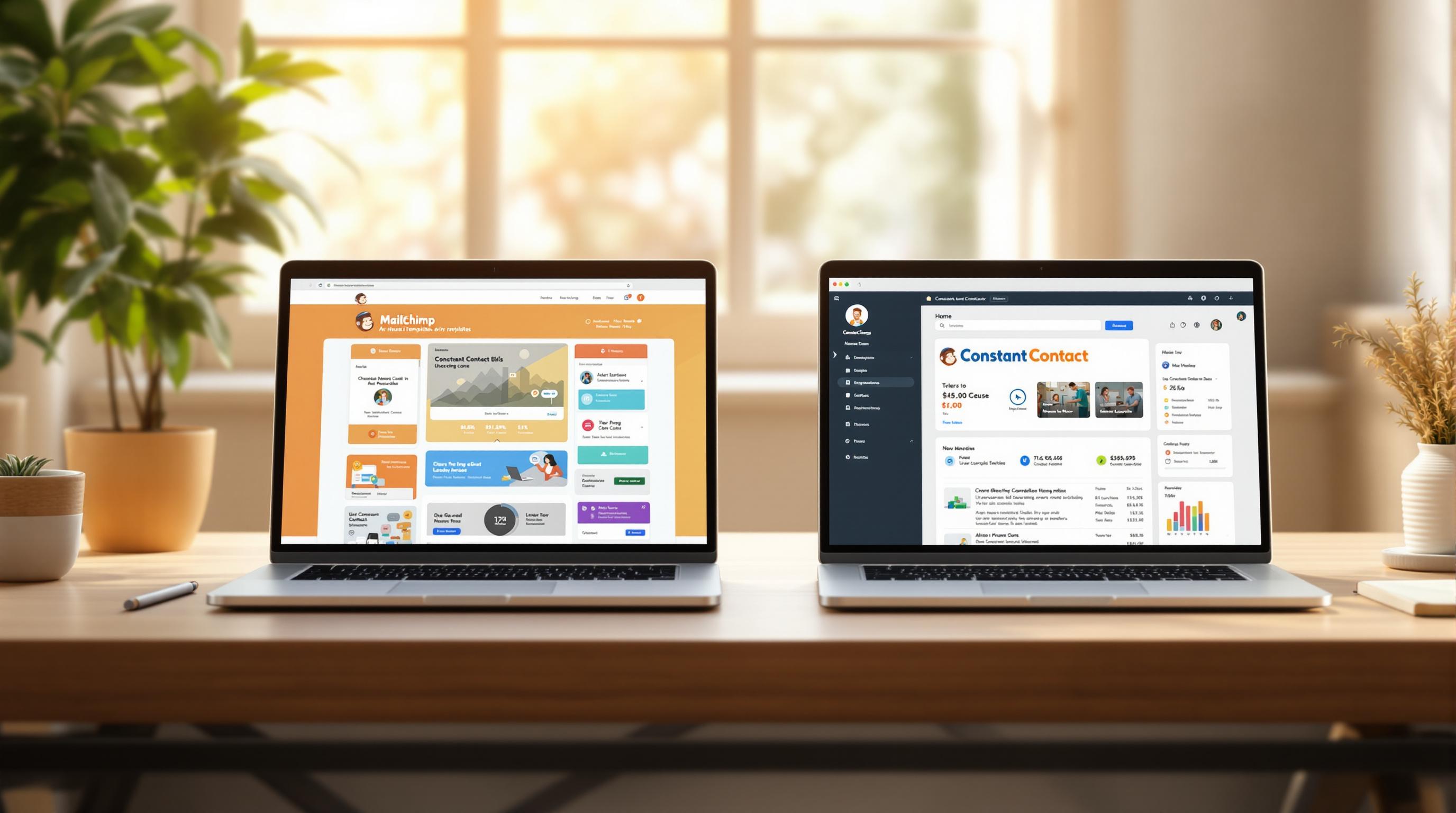Email bounce rates can hurt your marketing efforts and sender reputation. A healthy bounce rate is between 2-5%. Higher rates can waste your budget, reduce deliverability, and even get your domain blocked. Here’s how to fix it:
- Use Double Opt-In: Verify subscribers to avoid fake or mistyped emails.
- Clean Your List Regularly: Remove invalid and inactive addresses.
- Segment Your Subscribers: Group by activity levels for targeted emails.
- Set Up Email Authentication: Use SPF, DKIM, and DMARC to build trust.
- Add CAPTCHA to Forms: Block bots from signing up.
- Track Delivery Metrics: Monitor bounce rates, delivery rates, and spam complaints.
- Personalize Content: Send relevant, tailored emails to engage readers.
- Avoid Spam Triggers: Stay away from words like "FREE" and misleading subject lines.
- Verify Your Sending Domain: Ensure your domain is authenticated for better deliverability.
- Stick to a Schedule: Send emails consistently to maintain trust with providers.
Quick Tip: If your bounce rate is over 5%, clean your list and check your authentication settings immediately. A clean list and proper setup can reduce bounce rates by up to 50%.
Related video from YouTube
1. Use Double Opt-In for Subscriptions
Want to slash your bounce rates? Double opt-in is your best friend. Instead of adding every email address straight to your list, this two-step process makes sure you're only getting real, active subscribers.
Here's how it works: When someone signs up, they get a verification email with a link to click. This extra step stops typos, fake addresses, and pesky bots from cluttering your list.
The numbers tell the story: Email providers report that double opt-in lists keep bounce rates under 2%. Compare that to single opt-in lists, which often see bounce rates soar to 5-10%. That's a BIG difference.
Setting up double opt-in is straightforward:
- Create a punchy confirmation email with a clear, clickable button
- Set up reminder emails for folks who haven't confirmed yet
- Keep records of when people confirm (it's good for compliance)
Most email platforms come with built-in double opt-in features, so you won't need to start from scratch.
Now that you know how to build a list of real subscribers, let's look at keeping that list fresh and clean.
2. Clean Your Email List Regularly
A messy email list filled with dead-end addresses can tank your delivery rates. While this might sound scary, there's good news: today's email tools can do most of the heavy lifting for you, automatically spotting and removing problem addresses.
"Regular list maintenance is the foundation of email deliverability. A clean list not only reduces bounce rates but also improves overall engagement metrics." - Return Path Email Deliverability Guide
Here's what you need to do to keep your list in top shape:
- Kick out bad addresses fast: When emails bounce permanently (like when an address doesn't exist), remove them right away. Tools like 250ok, Return Path, and YesMail can help you spot risky addresses before you hit send.
- Watch who's actually reading: Keep an eye on subscribers who've gone quiet for 6-12 months. You've got two options here: try to win them back with a "We miss you" campaign, or say goodbye to keep your engagement numbers strong.
Need help? The Email Service Business Directory lists tools that can automate this cleanup work for you.
Pick a schedule that matches your sending volume - maybe it's monthly, maybe it's every three months. Think of it like regular oil changes for your car: it keeps everything running smoothly and helps your emails actually land in inboxes.
With a squeaky-clean list in hand, you're ready to tackle the next challenge: organizing your subscribers for maximum impact.
3. Organize Your Email List by Segments
Smart list segmentation helps you send the right emails to the right people. It's like creating custom groups based on what your subscribers care about. Just look at Pipedrive - they sorted their subscribers by engagement levels after cleaning their list, which led to better delivery rates and more sales.
Here's a simple way to group your subscribers:
- Super Fans: People who opened emails in the last 30 days
- Regular Readers: Those active within 90 days
- Casual Browsers: Opened something in the last 180 days
- Sleepy Subscribers: No activity for over 6 months
"Re-engaging inactive subscribers through targeted segmentation can significantly improve deliverability and revenue. When you treat different segments differently, your bounce rates naturally decrease because you're respecting engagement patterns." - Return Path Email Deliverability Guide
Match your email frequency to each group. Your Super Fans might love weekly updates, but Casual Browsers might prefer just one email per month. This approach keeps your engagement strong and your bounce rates low. Plus, you'll get fewer spam complaints because people get emails they actually want to read.
Quick Tip: Let your email platform do the heavy lifting. Most good ones have built-in tools for this. Need a platform with better segmentation features? Check out the Email Service Business Directory.
After you've got your groups sorted out, it's time to set up email authentication to build trust with inbox providers.
4. Set Up Email Authentication
Think of email authentication as your digital passport - it proves you're who you say you are when sending emails. Without it, your messages might end up in spam or bounce back completely.
Here's what happens when you skip this step: Email servers get suspicious, your messages bounce, and your sender reputation takes a hit. You could even get blocked from sending emails altogether.
"Email authentication is essential to getting your emails delivered into your subscribers' inboxes. It's the way you verify that the domain used in the From address is under the control of you, the sender." - FulcrumTech
You'll need three main methods working together to protect your emails:
- SPF: Tells servers which IP addresses can send emails from your domain
- DKIM: Adds a digital signature to prove your emails are legitimate
- DMARC: Keeps track of how well your authentication is working
Want to get started? Begin with SPF - it's your foundation. Once that's running smoothly, add DKIM for extra security. Finally, set up DMARC to watch how everything's performing. Tools like MXToolbox or your email platform's built-in reports can help you check if everything's set up right.
Keep an eye on your authentication setup regularly. While it might seem like a hassle, good authentication is your ticket to getting emails into inboxes instead of spam folders.
Now that you've got your email ID sorted, let's tackle another challenge: stopping fake sign-ups before they hit your list.
5. Add a CAPTCHA to Sign-Up Forms
Want to keep pesky bots from filling your email list with fake addresses? Put a CAPTCHA on your sign-up forms. It's like having a bouncer at the door who lets real people in while keeping the troublemakers out.
Today's CAPTCHAs are much more sophisticated than the old-school squiggly text. You've got options:
- Google's invisible reCAPTCHA v3 that works behind the scenes
- Quick image selection tasks ("pick all the traffic lights")
- Simple math questions that humans can solve in seconds
Pro tip: Place your CAPTCHA right next to the submit button. This spot catches bots without making the form feel like an obstacle course for real people.
Think of CAPTCHA and double opt-in as your dynamic duo for list quality. CAPTCHA stops the bots at the door, while double opt-in makes sure everyone who gets through actually wants to be there.
Here's the key: Monitor how your CAPTCHA performs. If you're getting complaints about the sign-up process, maybe dial back the security a notch. If you're seeing suspicious activity, tighten things up. It's all about finding that sweet spot where bots stay out and real subscribers get in easily.
Once you've got your CAPTCHA running smoothly, you can focus on what really matters - tracking how well your emails connect with your audience.
sbb-itb-6e7333f
6. Track Email Delivery Metrics
Want to know if your emails are actually reaching your subscribers? Let's dive into the numbers that matter.
First, let's talk about bounces. You'll see two types: hard bounces (invalid email addresses) and soft bounces (temporary issues like full inboxes). While you can give soft bounces another shot, keep an eye on patterns.
Here's what you need to watch:
| Metric | Target Rate | Why It Matters |
|---|---|---|
| Delivery Rate | >95% | Shows emails reaching actual inboxes |
| Bounce Rate | <2% | Tells you if your list is healthy |
| Spam Complaint Rate | <0.1% | Keeps you in good standing with email providers |
| Inbox Placement | >80% | Confirms emails land in the main inbox |
Think of these metrics as your email campaign's health check. The math is simple: to find your bounce rate, take your bounced emails, divide by total sent, and multiply by 100.
Here's something important: If you're seeing bounce rates above 5% across multiple campaigns, it's time to act. Pull your performance data from the last 30-60 days and consider cleaning your list with an email validation service before your sender reputation suffers.
Different email providers (like Gmail and Yahoo) have their own rules, but they all agree on one thing: keep those spam complaints under 0.1%. Go above that, and you might run into trouble.
Need better tracking tools? Check out the Email Service Business Directory - they've got options for every need and budget.
Now that you've got your metrics sorted, it's time to make your emails more personal and engaging for your audience.
7. Personalize Email Content
Want your emails to land in inboxes instead of spam folders? The secret goes beyond just adding someone's name to the subject line.
Smart personalization makes your emails feel like they're coming from a friend, not a robot. When subscribers get content they actually care about, they're more likely to open, read, and engage with your messages - and less likely to hit that spam button.
Here's what modern email personalization looks like in 2024:
| Level | Impact | What to Include |
|---|---|---|
| Basic | Good | Names, company details |
| Mid-Level | Better | Past purchases, website activity |
| Pro | Best | Smart content picks, perfect timing |
"Personalizing your emails has a dual benefit in that it's more likely to get past spam filters and get opened." - Outfunnel
Think beyond just slapping a name on your email. Studies show that sending content your subscribers actually want makes a huge difference. Here's what works:
- Track what your subscribers do, then send content that matches their interests
- Talk about problems they're facing in their industry
- Suggest products based on what they've bought before
- Send emails when they're most likely to read them
Need help getting started? Check out the Email Service Business Directory - it's packed with tools that can help you automate your personalization while keeping that human touch.
Just remember: even the best personalization won't help if your emails contain spam triggers. Let's look at how to avoid those next.
8. Avoid Common Spam Triggers
Did you know that spam filters block 20-30% of all emails? One wrong move and your message might never reach its destination. Let's look at what makes spam filters tick - and how to stay on their good side.
Think of spam filters as bouncers at an exclusive club. They're looking for specific red flags that tell them "this email doesn't belong here." Here's what catches their attention:
| Trigger Type | Examples | Impact on Deliverability |
|---|---|---|
| Promotional Words | "Free", "Discount", "Limited time" | High risk |
| Text Formatting | ALL CAPS, Multiple!!!, $$ | Medium risk |
| Subject Line Issues | Clickbait, Misleading promises | Very high risk |
Small changes make a big difference. Instead of blasting "FREE OFFER!!!" try something like "Exclusive member benefit" - you'll say what you need to say without setting off alarms.
"If you consistently send spammy looking emails, spam filters – essentially gatekeepers of the email world – can flag you address or whole domain and just bounce your messages right back to you." - Outfunnel
Here's how to keep your emails flowing to inboxes:
- Test your campaigns with tools like Mail-Tester before sending
- Craft clear, honest subject lines (keep them under 50 characters)
- Use your custom domain and proper authentication (remember those SPF, DKIM, and DMARC settings from Section 4?)
Here's a neat fact: Adding personal touches to your subject lines boosts open rates by 26%. But it's not just about getting opens - personalization helps your emails slip past spam filters too. Just make sure you've got your sending domain verified - it's like having a VIP pass that tells filters "yes, this sender is legit."
9. Verify Your Sending Domain
Think of domain verification as your email's VIP pass to the inbox. Here's something that might surprise you: less than 40% of brands set up their email authentication properly. That's a huge opportunity for you to stand out.
You need three key players to make this work: SPF, DKIM, and DMARC. Together, they tell email providers "Hey, these emails are actually from us!"
Here's what each piece does:
| Authentication | What It Does | How It Helps |
|---|---|---|
| SPF Records | Says which servers can send emails | Stops emails from bouncing |
| DKIM | Signs your emails digitally | Gets more emails delivered |
| DMARC | Controls how emails are handled | Keeps your sender name clean |
"Verifying your domain tells the receiving email server that, yes, you're a legitimate sender and that you have permission to send emails from this domain." - Outfunnel
Keep an eye on your setup. If you see your bounce rates suddenly jump up, it's often a sign that something's wrong with your authentication. And here's the thing: high bounce rates don't just hurt your current emails - they can make future emails more likely to fail too.
Want the best results? Use all three authentication methods together. Tools like MXToolbox can help you check if everything's set up right. Think of it like triple-checking your locks before leaving home - it's worth the extra effort.
Once you've got your domain verification sorted out, you'll want to focus on when you send your emails - but that's coming up next.
10. Stick to a Consistent Sending Schedule
Here's a fact that might shock you: Companies that send emails irregularly face bounce rates up to 3x higher than those who stick to a schedule. Why? Email providers get suspicious when your sending patterns look like a spammer's.
Pick a schedule that makes sense for your business:
- News sites and deal platforms → daily emails
- Most businesses → weekly emails
- Seasonal businesses → monthly emails
Keep it simple and doable. It's better to send one solid email every week than to blast out random bursts of content whenever you feel like it.
"Going dark and sending emails infrequently can, over time, contribute to an increase in bounce rates." - Outfunnel
Watch your analytics to find the sweet spot for sending times. If you spot high bounce rates at certain times (like those dreaded Monday mornings), switch things up. Keep an eye on those delivery stats we talked about in Section 6.
Here's the bottom line: Email providers are like cautious bouncers at a club - they want to see familiar faces showing up at regular times. When you stick to a schedule, they're more likely to wave your emails through to the inbox VIP section. Plus, your subscribers will know exactly when to expect your content, which builds a stronger connection with your audience.
Conclusion
Want to keep your emails from bouncing back? Let's look at what the numbers mean and what you should do about them:
| Bounce Rate | Status | What To Do |
|---|---|---|
| 0-2% | Great | Keep doing what you're doing |
| 2-5% | Looking good | Keep an eye on things |
| 5-8% | Time to act | Clean up your email list |
| 8%+ | Red alert | Drop everything and fix this now |
Here's the deal: if your bounce rate shoots past 8%, you're in trouble. Email providers might block your domain, and your reputation takes a hit. But don't worry - you can fix this.
"Regular list cleaning and proper authentication are the cornerstones of email deliverability. When combined with strategic segmentation, businesses can see bounce rates drop by up to 50%." - Pipedrive Email Marketing Team
Success in email marketing boils down to two things: building trust with your audience and sending them stuff they actually want to read. Setting up SPF, DKIM, and DMARC helps build that trust and keeps those bounces down.
Need help getting started? Check out the Email Service Business Directory. They've got the tools and services you need to keep your email list clean and your messages landing where they should.


